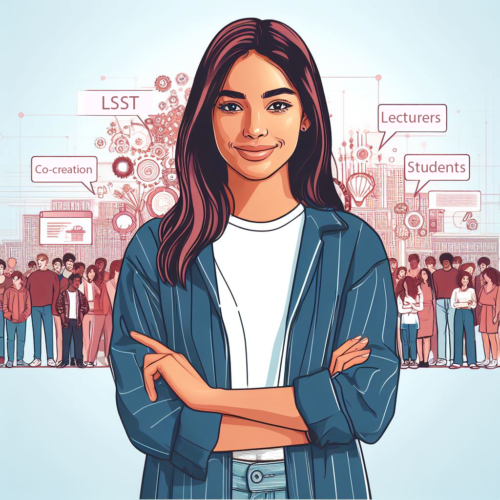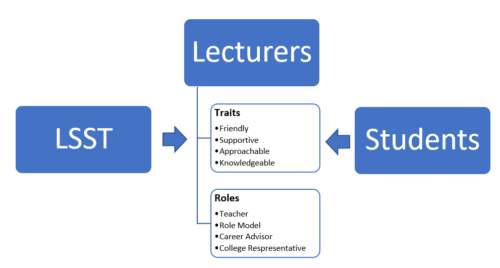CO-CREATION APPROACH OF ENHANCING STUDENT EXPERIENCE: A LSST CASE STUDY
Article Date | 10 November, 2023
By Dr Khadija Rauf, Senior Lecturer in Business, LSST Luton
In partnerships involving multiple higher education institutions, students can often struggle to identify the appropriate source for information. This is where Lecturers play a vital role in clarifying the distinctions – and similarities – between the institutions, helping students grasp the purpose of these partnerships. This article advocates for a collaborative approach, where LSST leverages its Lecturers to co-create an enriched student experience.
Research by Davies et al. (2010) highlights the significance of employees as crucial internal stakeholders, aiding organisations in achieving their objectives. In higher education, lecturers (as employee stakeholders) contribute by ensuring student satisfaction, meeting their expectations, and promoting retention and progression. Existing literature reinforces the idea that lecturers profoundly influence students’ perception of service quality in higher education (see Hill et al., 2003; Pozo-Munoz et al., 2000). Lecturers, being attuned to student expectations, can adapt, positively impacting perceived service quality and student satisfaction levels.
A Case Study Approach
LSST partners and collaborates with UK universities to provide accredited degree education, benefiting diverse local communities. This article highlights the institution’s key aspects, emphasising the lecturer’s role in ensuring student success and satisfaction. The insights shared reflect my own teaching approach at LSST.
Pleasant and Supportive Environment
At LSST, most students are returning to education after a substantial gap, juggling work and family commitments. To support them effectively, I cultivate a pleasant classroom atmosphere. I employ diverse active learning techniques like individual and group activities, informal discussions, and problem-solving exercises. This approach helps pinpoint each student’s unique learning needs, allowing tailored strategies for their development. For instance, mastering research methods and applying them is crucial, but many students require extra time and support. Using a positive attitude and accessibility outside the class can ensure all students grasp this topic equally. I conduct additional workshops and one-on-one sessions, particularly for research students, addressing their specific research challenges.
Student Developmental Training
Likewise, in quantitative modules demanding technical skills like Microsoft Excel and Panopto, I have created detailed guides. These documents explain how to submit video assessments and other statistics-based tasks. I also arrange training sessions to help students navigate Virtual Learning Environments (VLEs) and tackle online exams effectively.
Student-Oriented Approach in the Classroom
At the start of the course, students often doubt how their learning connects to the real world. To bridge this gap, I facilitate informal class discussions and conduct personalised feedback sessions. This approach helps pinpoint students’ weak areas and where they require extra assistance. Based on this insight, tailored strategies are implemented. For instance, I group weaker students, enabling them to learn from peers and progress together. My student-focused approach ensures equal treatment for everyone, fostering trust. This inclusive environment encourages students of all ages, genders, and races to openly share their concerns without hesitation.
Insights from the Practical World
I consistently motivate students to actively participate in class by offering practical examples aligned with their interests, re-engaging those who might have lost focus. Connecting lecture content with assessments significantly boosts student engagement. Additionally, explaining concepts deliberately and revisiting them aids students in understanding and applying knowledge effectively in assessments.
Lecturer as a Career Counsellor
At LSST, our student body is incredibly diverse, spanning a wide age range. I firmly believe that adopting a student-focused approach fosters trust. When students trust their lecturers, they rely on us for information, eliminating the need to seek clarification from partner universities.
Many LSST students seek to enhance their skills and secure high-paying jobs. They pursue higher education to open doors to better opportunities. While some students are mature, they lack the confidence to apply for managerial roles. Here, lecturers can step in as career advisors.
In my role as a Senior Lecturer in Business, I enthusiastically endorse our courses for their potential to enhance employability. I consistently urge my students to leverage their education. For instance, during marketing modules, I emphasise that the knowledge gained enhances employability across sectors. With this expertise, they can apply for marketing positions in various companies, as marketing is integral to all industries. Furthermore, I highlight the option of freelancing, enabling them to craft marketing strategies/plans for individuals or businesses in their community.
By helping students envision clear career paths related to their courses, we significantly boost their satisfaction. This approach instils a sense of purpose, making them feel actively engaged in professional development rather than merely accumulating knowledge.
Promote Employability as a Researcher
In my role as a supervisor at LSST, I consistently emphasise the broader applications of research skills, extending beyond their current projects to future higher education endeavours and research-intensive careers. Serving as a supervisor strengthens my rapport with students, and I frequently receive emails from former students seeking guidance on their advanced studies or career paths.
Co-Creation Approach for LSST to Enhance Student Satisfaction
Co-creation, in the context of a business, refers to a product or service design process in which input from consumers plays a central role from beginning to end (Ramaswamy and Ozcan, 2014). Similarly, in higher education, the process of co-creation allows institutions to improve the student experience and enhance students’ ability to act as a partners (Pozo-Munoz et al., 2000). Based on my experience of teaching at LSST and observing my fellow lecturers perform their formal and informal duties and adopted roles and behaviours, I propose that the development and maintenance of student satisfaction at LSST is a co-creation process. Students, by assigning multiple roles to lecturers and expecting a range of traits from them, rely on the performance of lecturers to evaluate their satisfaction. When asked to think of LSST, students primarily visualise their lecturers while evaluating their satisfaction during surveys such as Module Evaluation Surveys and National Student Survey. The following diagram visually represents the co-creation process where student-lecturer interaction is the delivery mechanism for student experience and student satisfaction. Research emphasises that strong student-lecturer interactions facilitate deeper engagement and improved experiences (Umbach and Wawrzynski, 2005; Bovill and Felten, 2016).

Recommendations and Managerial Implications
Considering the explanation above, lecturers play a crucial role within this institution, enriching student experience and satisfaction. Hence, it’s advisable for management to foster closer collaboration with academic staff, ensuring they have the necessary resources and support. Regular and direct communication between leadership and academic staff is suggested. This helps convey the institution’s short and long-term goals and keeps them informed about information intended for students.
References
Bovill, C. & Felten, P. (2016). Cultivating student–staff partnerships through research and practice. Taylor & Francis.
Davies, G., Chun, R. & Kamins, M. A. (2010). Reputation gaps and the performance of service organizations. Strategic Management Journal, 31, 530-546.
Hill, Y., Lomas, L. & Macgregor, J. (2003). Students’ perceptions of quality in higher education. Quality assurance in education, 11, 15-20.
Pozo-Munoz, C., Rebolloso-Pacheco, E. & Fernandez-Ramirez, B. (2000). The’Ideal Teacher’. Implications for student evaluation of teacher effectiveness. Assessment & Evaluation in Higher Education, 25, 253-263.
Ramaswamy, V. & Ozcan, K. (2014). The co-creation paradigm. Stanford University Press.
Umbach, P. D. & Wawrzynski, M. R. (2005). Faculty do matter: The role of college faculty in student learning and engagement. Research in Higher education, 46, 153-184.





Nicely put together and having the same teaching experience, I can relate to what you have written. However, the question is what sort of resources and support you are asking/looking for from senior management. How can we include students from such backgrounds in co creation?